Class:
Gastropoda
![]() Subclass:
Pulmonata
Subclass:
Pulmonata
![]() Superorder:
Eupulmonata
Superorder:
Eupulmonata
![]() Order:
Stylommatophora
Order:
Stylommatophora
![]() Suborder:
Orthurethra
Suborder:
Orthurethra
![]() Superfamily:
Pupilloidea
Superfamily:
Pupilloidea
![]() Family:
Vertiginidae Fitzinger 1833
Family:
Vertiginidae Fitzinger 1833
![]() Source:
Mollbase on
http://www.mollbase.de/list/.
Source:
Mollbase on
http://www.mollbase.de/list/.
Whorl snails are very small snails in the superfamily of chrysalis snails (Pupilloidea). The shells, mostly only some millimetres in size, are oval to cylindrical with a smooth or also strongly ribbed surface. The aperture almost always is narrowed by some protrusions ("Teeth", lamellae or a callus). Mostly this armature is typical for a specific species. The snails themselves only possess two tentacles (with the exception of the Gastrocoptinae subfamily), on which the eyes are placed. The smaller tentacles are mainly reduced. Nevertheless, whorl snails are terrestrial pulmonate snails (Stylommatophora).
Desmoulins' Whorl Snail - Vertigo moulinsiana (Dupuy 1849)
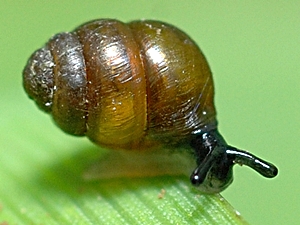 Desmoulins' whorl snail (Vertigo moulinsiana). Picture: Gilles St. Martin (Original). |
Description: Desmoulins' whorl snail is the largest whorl snail in central Europe. It has a translucent and very shiny reddish brown shell. The apertural whorl is strongly widened and may take as much as two thirds of the shell height. The aperture shows four lamellae standing near each other, narrowing the aperture's diameter and preventing predators from entering the shell. Also, they minimize evaporation. Of the four lamella, two are on the palatal (right) side, and one on the columellar (left) side and the parietal (upper) side each.
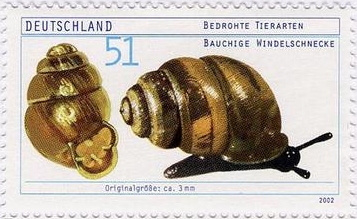 This stamp of Demoulins' whorl snail (Vertigo moulinsiana) was produced in a joint venture with the State Museum of Natural History in Stuttgart. Source: Hans-Jörg Niederhöfer. |
The snail's head and the largest part of its foot are black, the foot's ventral part has a lighter colour.
Dimensions: H: 2.25 - 2.75 mm ; W: 1.3 - 1.65; N: 3˝ - 4˝. (Abbreviations).
Habitat and Distribution: Desmoulins' whorl snail preferably lives in the swampy bank area of stagnant waters, such as lakes and ponds. It characteristic for sedge reed habitats, where it feeds on microbial fungi on the sedges during the night. Vertigo moulinsiana also aestivates there and probably is distributed by water birds. It avoids actually wet places, but needs a warm and humid microclimate.
Desmoulins' whorl snail can be found in a disperse manner in Germany - in the north and north-east it is relatively common. There are sporadic populations of this species in all of central and western Europe, on the British Isles and southern Scandinavia. In the south the species' distribution area stretches as far as North Africa, in the east until the Caucasus. Intact populations of Vertigo moulinsiana have been found in south-eastern England, in Ireland and in the north-east of Germany.
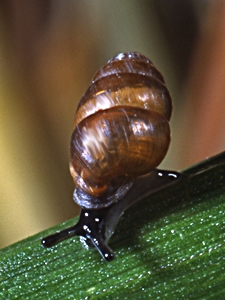 Desmoulins' whorl snail (Vertigo moulinsiana). Picture: F. Julich (Source). |
It seems probable that the isolated populations of Desmoulins' whorl snail, a species quite sensible to deep winter temperatures, assumedly are relics of the warm postglacial period. This, however, is disputed.
Threat Situation: Vertigo moulinsiana is severely threatened, mainly because of its populations' appearing very locally, its high standards of habitat quality, as well as destruction of its biotopes, such as ground water descent, drainage of wetland biotopes and lakesides grown with sedges, as well as the agricultural use of those habitats, by mowing and as pastures.
Extinction threatens nearly in all of the species' distribution area. Though most of the historically reported populations probably might be extinct already, Vertigo moulinsiana has managed to settle in alternative habitats and so is assumed to be more frequent than previously thought.
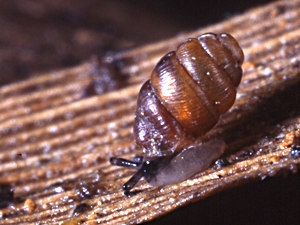 The left-handed narrow mouthed whorl snail (Vertigo angu- stior), also a threatened species. Picture: F. Julich (Source). |
Critically endangered (CR), Vertigo moulinsiana definitively is in Bavaria, Austria
and southern Switzerland, part of Italy and Rhineland-Palatinate. In the rest of
Germany, Switzerland and Italy, the species is classified as vulnerable (VU), in
Spain as near threatened. Demoulins' whorl snail is rare in Britain and Ireland;
assumedly, it is already vulnerable (VU) in Wales (see also:
![]() IUCN Threat Categories).
IUCN Threat Categories).
According to a decision of the Fauna-Flora-Habitat guideline (FFH) in Germany of the year 1992 as "guideline 92/43/EWG of the council of May 21st, 1992 concerning the protection of natural habitats, as well as wild-living animals and plants" (Council of the European Communities, 1992) for Vertigo moulinsiana special protection areas have to be to be installed.
In 2002 German Mail edited a stamp with Demoulins' whorl snail as a motive. In 2003 the respective trust elected the species mollusc of the year.
![]() Research
group Molluscs NRW:
Mollusc of the year
2003: Vertigo moulinsiana. (In German)
Research
group Molluscs NRW:
Mollusc of the year
2003: Vertigo moulinsiana. (In German)
![]() Mollbase
Species Protection:
Vertigo moulinsiana.
Mollbase
Species Protection:
Vertigo moulinsiana.
![]() Francisco
Welter-Schultes:
Vertigo moulinsiana species homepage.
Francisco
Welter-Schultes:
Vertigo moulinsiana species homepage.
![]() A. W. Gmelig
Meyling und R. H. de Bruyne:
Zeggekorfslak,Vertigo moulinsiana
(Dupuy, 1849) (In Dutch)
A. W. Gmelig
Meyling und R. H. de Bruyne:
Zeggekorfslak,Vertigo moulinsiana
(Dupuy, 1849) (In Dutch)
Cylindrical Whorl Snail - Truncatellina cylindrica (Férussac 1807)
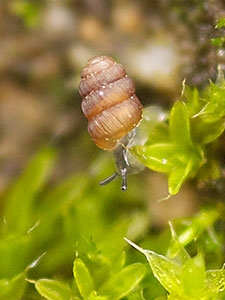 Cylindrical whorl snail (Truncatellina cylindrica). Height: ca. 2 mm. Zurich, Switzerland. Picture: © Stefan Haller (schneckenfoto.ch). |
The species in the Truncatellina are among the "smallest and most delicate of pulmonates" (Ehrmann, P., 1956).
Description: The cylindrical whorl snail has a golden brown to horn coloured shell, which is not smooth, but ribbed, the spaces between the ribs as wide as the ribs themselves. The whorl before the apertural whorl shows about 65 ribs. The shell appears to be slightly conical: The whorls grow slightly towards the aperture. The aperture rim is only folded back a little and does not show any visible apertural teeth or lamellae.
Dimensions: H: 1,8 - 2 mm; W: 0,9 mm; N: 5˝. (Abbreviations).
Habitat and Distribution: The cylindrical whorl snail lives on sunny slopes in dry and moderately dry places. Truncatellina cylindrica prefers calciferous ground, but in meadow habitats also lives and sandy and stony ground, as well as in the vegetation cover of limestone rocks. In the south of their distribution area the tiny snails also live in forests with lots of light. In Central Europe and England, it is typical for Truncatellina cylindrica to live on sedum and mugwort (Artemisia) plants. In Switzerland, Truncatellina cylindrica snails often live on dry and warm limestone rocks exposed to the south.
The species' distribution area stretches from England and southern Scandinavia in the north to Central Russia and the Caucasus mountains in the east, South Europe and Turkey in the south and south-east, as well as to North Africa.
Threat Situation: The cylindrical whorl snail is threatened
by the continuous destruction of its habitats (as many whorl snail species are):
Most populations in Great Britain are already disappeared. In Ireland the
species already is extinct, in Scotland it probably may be. In Vorarlberg and
Lower Saxony, the species is classified endangered (EN), in England and the rest
of Germany, Truncatellina cylindrica is classified as vulnerable (VU) (see also:
![]() IUCN Threat Categories).
IUCN Threat Categories).
![]() Francisco
Welter-Schultes:
Truncatellina cylindrica species homepage.
Francisco
Welter-Schultes:
Truncatellina cylindrica species homepage.
![]() Anderson, R. (2008): "An annotated list of the non-marine Mollusca of Britain and
Ireland" (PDF).
Anderson, R. (2008): "An annotated list of the non-marine Mollusca of Britain and
Ireland" (PDF).
![]() Harry G. Lee:
Selected Vertiginid species from the United Kingdom.
Harry G. Lee:
Selected Vertiginid species from the United Kingdom.
 With pictures by Stefan Haller: http://www.schneckenfoto.ch. |